Don’t serve your coffee from a chocolate pot!

What makes a chocolate pot different from a teapot or coffee pot?
Because anything induced by chocolate MUST be a good idea, its time for another chocolate-induced dive down the research rabbit hole!
Just to refresh your memory a bit, during the regency era, there were three particular luxury drinks: tea, coffee and chocolate. (I talked about tea recently, you can find that HERE. The first chocolate article is HERE.) They were in high demand, but expensive to acquire and, in the case of chocolate, difficult to make.
Preparing drinking chocolate took at least thirty minutes and (ideally) a number of specialized tools for both preparation and serving. But people haven’t changed much in the last several hundred years. Those who couldn’t afford all the special tools still drank chocolate, making do with what they already had in their kitchens. They also drank chocolate out of whatever they had available, even tankards. (Given the size of some of those chocolate cups, a tankard doesn’t really sound like such a bad idea to me…)
All of that aside, what tools were needed?
To start, a specialty chocolate grater would be used to shave chocolate from a solid and very hard tablet of chocolate and spices like cardamom, aniseed, cloves, and bergamot. I’ve got to admit, that latter one has me a little skeptical. There is a reason why chocolate-covered fruit loops aren’t a thing. (If you’re not familiar with it, in my humble opinion, bergamot tastes just like fruit loops) But I suppose whatever floats your boat, right? For me, I’ll take cinnamon in my chocolate.
The powdered chocolate would be added to a large pan or chocolate pot containing water, milk or possibly a mixture of water and wine or brandy and brought to a boil, while constantly stirring to prevent scorching. (No small feat when you consider that we’re talking about cooking over fire, not the carefully controlled heat of a gas or electric stove.) A special tool, known in England as a chocolate mill (in France a molinet, in Spain a molinilla) would be used to beat in thickening agents and create froth on the top.
There is a knack to using a molinet. You roll the handle between your hands to spin it in the chocolate rather than using a traditional stirring motion. That allows the tool to move much faster and introduce more air into the chocolate. It also tends to splash when you do this, so you may just end up wearing a great deal of your chocolate if you’re not careful.
Below are a few examples of the molinet.
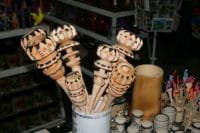
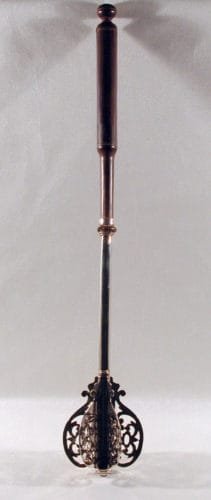
Once the chocolate was ready, special pots, known in France as a chocolatière, were designed just for serving it. At first, when chocolate was a luxury limited to only the most elite, chocolate pots were made exclusively of silver with fine hardwoods or ivory used for the finials. In the early 1700’s, porcelain chocolate pots were made in China for export to Europe. Later, sturdier (and less expensive) pots were made of pewter or earthenware.
Chocolate pots tended to be tall and relatively slender, looking a lot like coffee pots, but with a few significant differences in the lid, the spout and the handle.
The lid
Drinking chocolate was very thick and tended to settle, so it was essential to continue whipping it with the molinet. To accommodate the molinet, a chocolate pot had a very distinct lid.
The top of a chocolate pot had a hole for the molinet handle to extend from, allowing the hostess to stir the chocolate without splashing herself or her guests. The hole might remain uncovered, but in many cases a special hinged or swiveling finial would cap the hole and help preserve the heat in the chocolate. Sometimes the finial might be attached by a chain to the pot so it would not get lost.
The vigorous action of the molinet left delicate porcelain chocolate pots at risk for breakage, so their lids were often made of silver or pewter to reduce the chance of damaging the pots during use.
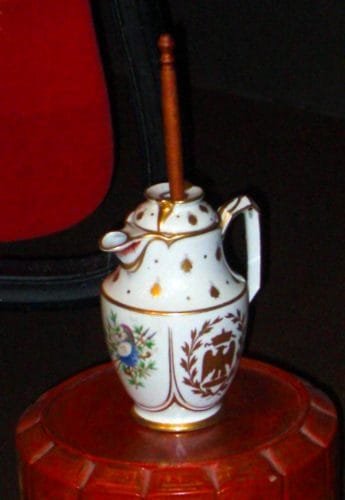
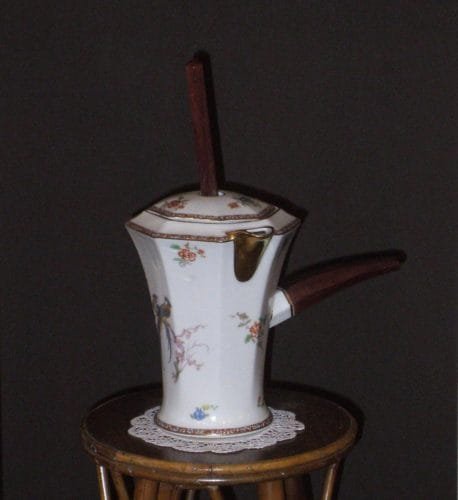
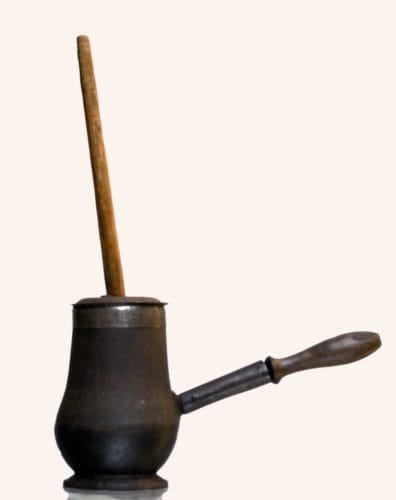

The spout

Spouts on chocolate pots were wide and set high on the pot. Both qualities relate to the froth on the top of the chocolate. Since the froth floats on top of the chocolate, locating the spout high helps to capture the foam. Similarly, a wide spout facilitates getting it into a serving cup.
A high spout also helps to keep the undesirable sediments that settled to the bottom out of the serving cups.
The handle
The earliest chocolate pots had handles set at right angles to the pot. Usually these were made of wood, with a bit of a knob at the end. After the later part of the 1730’s chocolate pots with looping handles in line with the pouring spout were produced.
Why the two different types of handles? Actually it was difficult to suss out a clear and definitive reason.
The best I could find was that the loop shaped handles were easier for women with weak wrists to pour.
The handle at 90 degrees (thought to be a bit more popular) required two hands to pour, one to man the handle and the other to keep the lid from falling off. I have read this also allowed for stirring the chocolate as you poured it, but I can’t for the life of me picture how that worked. However, I have also read that this sort of handle makes it easier to pour the upper half of the vessel, which is where the most desirable foam and drinking chocolate would reside, and easier to keep the undesirable gritty bits at the bottom in the pot.
Take a peek at what these different pots would look like.
Handles at 90 degrees:


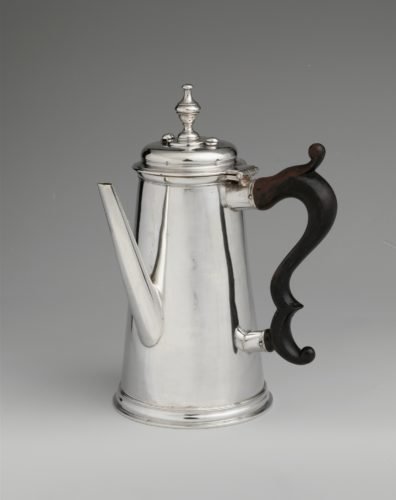



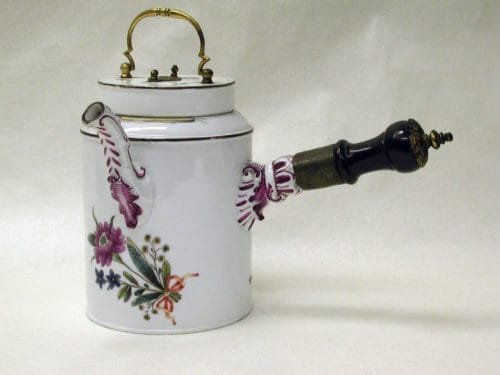
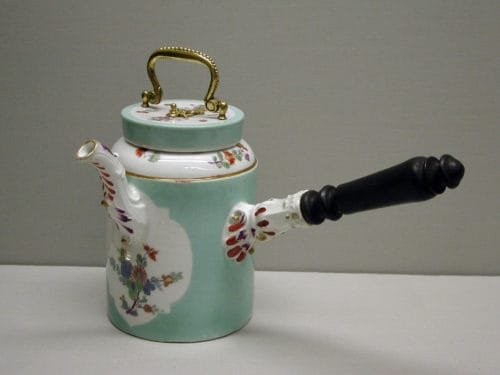
Handles in line with the spouts.

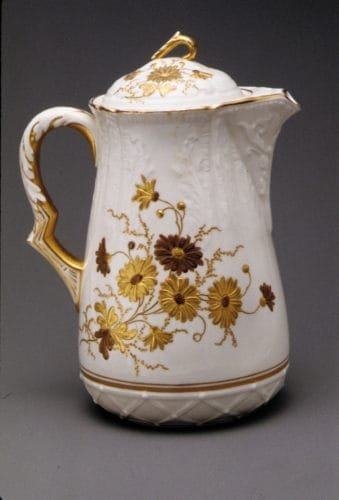
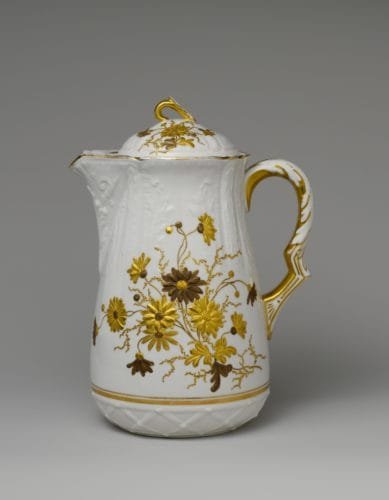

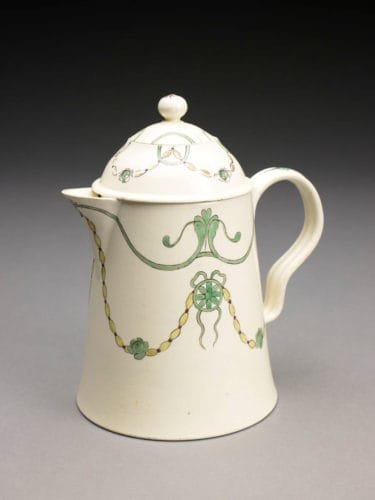

How did chocolate specifically differ from tea or coffee pots?
Teapots tend to be short and stout (remember the kids’ song?) The round shape allows room for the tea to move in the pot, allowing it to seep more effectively. Their short spouts come from the center of the pot and sometimes have a grate behind to keep the tea leaves from clogging the spout. The short length makes them easier to clean if leaves get trapped inside the spout.
Coffee pots are designed to help maintain the heat of the beverage, which preserves its flavor. The taller, narrow shape helps minimize heat loss. The longer, low-mounted spout helps keep cool air from circulating into the pot.
A proper regency hostess would have been able to identify these pots at just a glance and probably would not consider serving chocolate from anything but a chocolate pot. For the rest of us though, chocolate served from another sort of pot would still be chocolate, right? And that has to be a very good thing indeed.
References
Images from wikimedia, Public domain and Creative Commons.
Deitz, Paula. “Chocolate Pots Brewed Ingenuity.” The New York Times. February 18, 1989. Accessed May 24, 2017. http://www.nytimes.com/1989/02/19/arts/antiques-chocolate-pots-brewed-ingenuity.html.
Kane, Kathryn. “Regency Chocolate: The Correct Accoutrements.” The Regency Redingote. August 02, 2011. Accessed May 24, 2017. https://regencyredingote.wordpress.com/2011/05/20/regency-chocolate-the-correct-accoutrements/.
Righthand, Jess. “A Brief History of the Chocolate Pot.” Smithsonian.com. February 13, 2015. Accessed May 24, 2017. http://www.smithsonianmag.com/smithsonian-institution/brief-history-chocolate-pot-180954241/.

A delightful and beautifully illustrated post, Maria Grace. I enjoyed it with my Scottish breakfast tea with a splash of milk and a McVittie’s biscuit.
Thanks, Linda! It was such fun to write!
Excellent article, Maria! When I get around to rebuilding my kitchen you can bet I’ll remember this. I may be able to do without coffee, but tea and chocolate are must haves!
After doing all the research, I went on ebay just for fun to look a chocolate pots. It was an exercise in frustration because so many pots were labeled incorrectly! Or worse, a lot were labeled: coffee pot/teapot/chocolate pot! Argh! They are not interchangeable!
That’ll teach me to dive down a research rabbit hole… LOL
So interesting!! Hot chocolate is one of my favorite drinks, so it’s fun to learn more about making it in days before Nestle. 😉
Warmly,
Susanne 🙂
Thanks, Susanne!
I am always amazed at the amount of research you do and how you still have time to not only write but have a life! Another reason I am glad I live in our day and age…heat water, add hot chocolate powder, stir. Thanks for the history lesson and the photos.
Thanks so much Sheila! It is so easy to get lost in the research rabbit hole!
Love having my chocolate each day enjoyed very much your research and photos.Thanks for same. Had been intrigued to see a chocolate pot after your mention of Kitty and Bingley’s love of chocolate in your very delightful book Twelfth Night at Longbourne Think you are a fantastic author Looking forward to more random bits of fascination
Chocolate pots always have a hole on the lid to insert the stirrer. Most have a high short spout ., but not always . Some have the long spout that coffee pots have . The difference is most coffee pots have a sieve at the pot end of the spout , but chocolate pots do not have a sieve ,otherwise the chocolate would be impeded in getting out . Coffee debris however needs to be prevented from getting into a cup .which the sieve achieves . A dual purpose jug would have the opening in the lid for the stirrer and no sieve in the spout for chocolate but still have a long spout for coffee. The coffee grains would then have to be collected in an out of pot strainer ,like a tea strainer .These dual purpose pots do exist . In other words not all chocolate pots have short spouts the important part in a chocolate pot is the hole in the lid for stirring
Pingback:Chocolate for Breakfast on Chocolate Day - Random Bits of Fascination